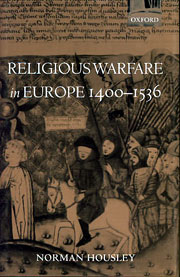

Religious Warfare in Europe 1400-1536

Religious warfare abounded in Europe between 1400 and 1536. A more skeptical view, however, would argue that warfare, which happened to use religious symbolism, abounded in Europe. This difference in interpretation is not merely academic. What was the true motivation of these wars? Or to phrase it in a slightly different manner: was the warfare that occurred in Europe (1400-1536) truly religious or was religion simply a device used to mask purely self-interested motives? This book argues that these wars contained a unique weave of both religious and self-interested motivations.
The religious wars of this period differed from the early Crusades meant to conquer the Holy Lands, although many elements overlapped. In particular, vows, the cross, and the indulgence continued to play crucial roles throughout the period. The religious wars, however, built upon the crusading mentality that first developed in relation to the Holy Land and merged it with the needs of the day. For example, many of the conflicts combined the crusading heritage with nationalist aspirations.
The Hussite rebellion provides a good example of the merging of the crusading imagery with nationalist ambitions. What started with the martyrdom of John Hus at Constance (1415) ended with years of bloodshed, where both sides saw themselves as defending God's laws. Before the war the Hussites formed a nascent political community and started to view themselves in nationalist terms. When confronted by an outside threat they coalesced around both their national identity and their religious beliefs (defenders of the lay chalice). The repeated successes against the Crusaders reinforced the Hussites' sense of community and religious purpose.
So was the rebellion a religious war or did the sides simply use the religious symbolism and beliefs to rally support for self-interested causes? Housley argues that these events had a definite and unique religious aspect that was independent of any self-interested motivation. Many of these centered on chiliastic [millenarian] and eschatological prophecies. In essence, even though religion served a materialistic purpose, it also independently influenced events.
In some sense, the people of this period encountered movements that they could not place within their traditional views of the world. What experience did the Czechs have with nationalism before the Hussite wars? When the changing environment created a unique situation the people reached out and placed them within a familiar context, i.e. religion. While religion helped them understand the situation, it also provided guidelines for actions.
One can also see this effect in how the European’s viewed and interacted with the “Turk.” The external Turk, according to Housley, deals with the image of the Ottomans as the physical manifestation of Islam and its threat to the Christian world. Yet Europeans used this image against its internal foes as well. Often the failure of Crusade planning was attributed to the Christians acting in a “Turkish” manner. In addition, individual Christians had to wage a continual fight against their interior Turk.
These changing images and applications of the Turk highlight a critical aspect of Housley’s argument. The crusading and religious imagery continued to play a critical role in the life of Christian Europe. Not only did these concepts help rally support against the external enemies, but also they were used to combat challenges that arose within the Christian community. This use of religious symbolism and conceptions makes the conflicts that Housley discusses religious wars.
In general, Housley does a good job in showing that religion played an independent role in these conflicts. Yet given their merger with self-interested motives, especially nationalist ambitions, is "religious war" really the correct characterization? Housley convincingly argues that religion was an independent force, but so were the self-interested motives. This means that one could just as easily have argued that these were "self-interested" or "nationalist" wars. This point is not merely semantic or about what factor was "most important; rather, different types of wars have varying dynamics.
The arousal of nationalist ambitions created a strain on the feudal system, especially for the more universal institutions of the Holy Roman Empire and Papacy. Eventually the nascent nationalism created friction that led to a number of wars (the Hussite Rebellions, for instance). But how could the combatants both conceive of and justify their fights? Nationalism was certainly not a legitimate grievance, and most likely, neither side could truly conceptionalize it. This inability to conceive of nationalist strife caused a turn to religion for understanding as well as justification.
This does not mean that religion did not have an independent effect. Housely does a great job in demonstrating that point. What it does mean is that religion was used as a frame through which the sides could understand their conflict. While this gave religion a role, it also meant that its time was limited. Once feudal society became better able to cope with and understand nationalist ambitions, the need to appeal to religion lessened and the era of Housley's "religious wars" came to an end.
